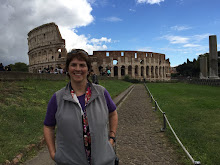But, I finally sat down and read it this morning before work. I've got a book club next week that is reading it, so I knew my time had come. This is a young adult novel, but it packs a wallop. Ruta's imagery, if written solely for an adult audience, could be taken up a notch in the graphic department, and cross over into just horrible scenes of death and destruction. She writes for a young adult audience, and while for some the scenes of life being treated so cavalierly, so without worth or care, are disturbing, I find them even more so because of her spareness of words, and the matter of fact way she writes about them. Growing up in a time of peace (Cold War as a child-yes, but nothing like a World War) in the United States, I simply cannot imagine how people not only survive(d) war, but how they cope with the after effects. I just don't think I could bear it. I don't imagine anyone thinks they can, but they do. I marvel at that.
This novel is told through four different people, all on the same mission. It is early 1945; Russia is making huge inroads into German territory, and the end is near. The Russian army is ruthless as they plunder, rob, murder, and rape across Poland, Lithuania, Prussia, and Germany. It's a mad dash to the Baltic sea, where Germany is trying to conduct a massive evacuation of troops and German citizens before the Russians arrive. In Salt to the Sea, we have Joana, a Lithuanian nursing student who is in German territory and trying to get to her family; Emilia, a Polish teenager hiding a terrible secret, who is rescued by Florian, a German young man who is also carrying a huge secret, and has been wounded by shrapnel. There is Alfred, who is a German solider with illusions of grandeur that become more and more outlandish. There's also Heinz, the shoe poet--an elderly shoemaker who has befriended a little boy (known as the wandering boy) on the road to safety. There are a few other characters that round out this group of rag-tag refugees, starving, freezing, and trying to avoid both Russian and German troops, all while enduring bombing from Allied aircraft on a daily basis. It's just simply intolerable, but tolerate it they do-the struggle to survive is fierce. Mistrust and language barriers create a lot of tension between the characters, as they find themselves on the same journey to safety, but not knowing if it will be safety or death when they arrive. I felt cold, tired, and worn out just reading about their journey.
The novel takes places over, I'd say, a few weeks time. Joana is so tough, so resourceful. Emilia, bless her, just makes your heart ache. Florian is torn between his duty--which is actually revenge--his growing feelings for Joana, and his reluctant concern for Emilia. The shoe poet is a kind old man who sees all, and is the voice of wisdom through it all.
All of this culminates in the short voyage and terrible tragedy of the Wilhelm Gustloff, a German ship that was packed with 10,000 soldiers and refugees, and torpedoed by the Russians mere hours into their journey to safety. Over 9,000 people died, in what is the worst maritime tragedy ever--outdoing the Titanic by thousands of lives lost. Most people never stood a chance. And guess where our characters have landed? On the Wilhelm Gustloff. Who lives, and who dies?
Oh, this was such a good novel. I unashamedly admit to crying at the end. War is so damn ugly. It destroys not only countries, but the best of humanity. There is no bouncing back from experiencing war. It stays with you forever. I am so glad Ruta Sepetys finished this novel with closure that helped in the mourning process for me. Yes, I actually had a bit of mourning for the characters. I was very touched by this novel, and now I'm deeply interested in learning more about the Wilhelm Gustloff. Unfortunately, there isn't much out there. The Germans certainly didn't want anyone to know about such a blow to their empire, and the Russians could have cared less about the horrible death toll. The Wilhelm Gustloff still lies at the bottom of the Baltic Sea, a massive grave to so many who were trapped as the ship went down within 10 minutes. Thousands survived the initial sinking, only to die in the freezing waters. Over 5,000 children perished. Haunting.
This is what I love about Ruta Septeys. She writes history for young adults, but it's so very personal to her in her quest to understand her Eastern European roots. It's some of the best historical fiction I've read. I am looking forward to her next novel, and have the patience to wait until she delivers it to the world.
Rating: 5/6 for an amazing novel that culminates in the portrayal of the worst maritime disaster in history, where over 9,000 people perished the Wilhelm Gustloff sinking during World War 2. She puts a face to the tragedy, the horror of war, and the decisions people make to survive and retain their humanity. You'll be turning towards history books and your computer to explore more after you've turned the last page.
Available in hardcover, paperback, ebook, and audio.



I for sure never heard of the Wilhelm Gustloff! How many reading groups do you attend? I am in several and do a Reading Group Update once a month on my blog. http://keepthewisdom.blogspot.com/2018/01/january-reading-group-update.html. I would love to know what you read for your groups.
ReplyDelete